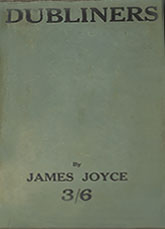Dubliners
Critique • Quotes • At the movies
 First edition
First editionFirst publication
1914
Literature form
Stories
Genre
Literary
Writing language
English
Author's country
Ireland
Length
Volume approx 70,500 words, "The Dead" approx. 16,000 words
Before he drowned in the stream
Dubliners is a wonderful collection of stories you can go back to at different times in your life and appreciate on different levels each time.
They were written and published before James Joyce got sidetracked by his experiments in stream of consciousness and linguistic gymnastics. It's also before he adopted his theme of poor-little-genius-me—he actually gets inside characters, who are not himself thinly disguised, with great sensitivity.
For the most part they're ordinary people depicted quite naturalistically in everyday situations in Dublin.
However, the stories are not all third-person-objective as might be expected. Joyce shows quite a lyrical bent. The stories are full of expressive sentences like "The cold air stung us and we played till our bodies glowed".
Nor are they all subjective monologue, as alternatively might be expected. Hardly any in fact. Rather in Dubliners Joyce uses the influential in-between kind of voice sometimes called free indirect style—combining third-person factual reporting of characters' behaviour with their first-person thoughts as they are experienced.
The stories are often inconclusive, sometimes hardly stories with narrative at all, but instead are built around still moments that each reveal in a sudden light an insight into the people or their situations in life. These moments of self-illumination are the near-mystical "epiphanies", as he called them, that Joyce avidly sought and collected for his later writing.
Through the gradual accumulation of stories about the small, seemingly insignificant incidents in the lives of his Irish subjects, Joyce comes to people the broad social network of Dublin at that time. Some of these characters reappear in peripheral roles in his later longer works, A Portrait of the Artist as a Young Man and especially Ulysses.
The Dead
The most acclaimed story in this collection is "The Dead" which concludes the volume on a note of profound sadness. A good-hearted but conventional man discovers the wife he loves had once experienced a tragic passion in her life.
The description of him watching the snow fall as she sleeps is heartbreaking in its simplicity. I'd like to quote the entire last beautiful paragraph but it would not be as effective without the story leading up to it.
This story is sometimes treated as a novella, despite being a bit shy of the word count usually associated with the short novel form. Perhaps the depths and complexities in this seemingly simple story, with its revelation of the inexorable gulfs between people, fool readers into thinking it is longer. James Joyce at his naturalistic best.
"The Dead" was made into a moving film by director John Huston, the last work of his own life, which is appropriate on several levels.
— Eric
Critique • Quotes • At the movies

